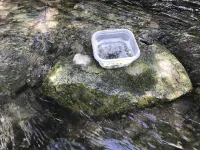(Press-News.org) It is time for the management and conservation of the Antarctic to begin focusing on responsibility, rather than rights, through an Indigenous Māori framework, a University of Otago academic argues.
In an article published in Nature Ecology & Evolution, Associate Professor Priscilla Wehi, of the Centre for Sustainability, says now is the time to be thinking of these potential changes.
"New Zealand is currently re-setting its priorities for future Antarctic research, and there may be review of the current international environmental conventions as we approach the 50-year anniversary of the protocols in 2048.
"We argue that Indigenous Māori frameworks offer powerful ways of thinking about how we protect the Antarctic, by focusing on responsibilities rather than rights, including the responsibilities we have to future generations," she says.
Antarctica is unlike any other place on earth - it is remote, there are no permanent human settlements, and no one nation has sovereignty.
"Consensus decision making by Antarctic Treaty nations will determine what happens next, but within that group there are many different interests and perspectives on what should happen, from mining rights through to ecosystem protection.
"Global conceptions of Antarctica are dominated by colonial narratives. On the other hand, an Indigenous Māori framework, focussing on relational thinking and connectedness, humans and non-human kin, and drawing on concepts of both reciprocity and responsibility, offers transformational insight into true collective management and conservation of Antarctica.
"Because mātauranga has a foundation where relationships between different parts of the universe, between humans and other living beings, and so on, are acknowledged and embedded, this is a very different way of examining the world and offers a different perspective on what we could - or even should - do next."
The article brings together mostly Indigenous researchers from Otago, Massey University, and Te R?nanga o Ngāi Tahu and is the first paper to bring Indigenous frameworks to the issue of what an Antarctic future might look like, Associate Professor Wehi says.
Human navigation into Antarctic waters dates back to about the 7th century with Hui Te Rangiora. Accounts of a frozen ocean and enormous ice cliffs were passed down through generations.
Observing and recording changes in the physical environment, naming and classifying areas of risk, and predicting environmental disturbance are critical for voyages like those of Hui Te Rangiora.
"Incorporating Indigenous environmental knowledge enhances our ability to understand, monitor, plan for, and adapt to weather and climate variability, but can also offer alternate frameworks from which to enhance practice," she says.
"Recognizing the intrinsic link between the well-being of tangata and whenua, Māori have an intergenerational obligation to ensure that the relationship with Antarctica is reciprocal and sustainable."
Co-author Associate Professor Krushil Watene, of Massey University, says Antarctica is one of the most important and one of the most fascinating places on Earth - both for science and philosophy.
"Antarctica challenges our perspectives, unsettles them and in doing so provides us with opportunities to reimagine our lives together, to reimagine our relationships with the natural environment, and to rethink our responsibilities globally.
"We need to urgently prompt thinking and discussion around the deep reflection and transformative change that Antarctica challenges us, as a global community to undertake. We need to be bold and brave in charting a future in which our planet can thrive. Philosophy generally, and indigenous philosophy in particular, brings important and valuable perspectives through which such futures can be charted," she says.
INFORMATION:
Publication details:
Transforming Antarctic management and policy with an Indigenous Māori lens
Priscilla M. Wehi, Vincent van Uitregt, Nigel J. Scott, Tasman Gillies, Jacinta Beckwith, Rata Pryor Rodgers and Krushil Watene
Nature Ecology & Evolution
https://doi.org/10.1038/s41559-021-01466-4
Invasive species, beware: Your days of hiding may be ending.
Biologists led by the University of Iowa discovered the presence of the invasive New Zealand mud snail by detecting their DNA in waters they were inhabiting incognito. The researchers employed a technique called environmental DNA (eDNA) to reveal the snails' existence, showing the method can be used to detect and control new, unknown incursions by the snail and other invasive species.
"eDNA has been used successfully with other aquatic organisms, but this is the first time it's been applied to detect a new invasive population of these snails, which are a destructive invasive species in fresh waters around the world," says Maurine Neiman, associate professor in the Department ...
How old is your brain compared to your chronological age? A new measure of brain health developed by researchers at Rush University Medical Center may offer a novel approach to identifying individuals at risk of memory and thinking problems, according to research results published in Alzheimer's & Dementia: The Journal of the Alzheimer's Association on June 1.
Dubbed the "cognitive clock" by the researchers, the tool is a measure of brain health based on cognitive performance. It may be used in the future to predict the likelihood of memory and thinking problems that develop ...
Rare disease experts detail the first results of an unprecedented collaboration to diagnose people living with unsolved cases of rare diseases across Europe. The findings are published today in a series of six papers in the European Journal of Human Genetics.
In the main publication, an international consortium, known as Solve-RD, explains how the periodic reanalysis of genomic and phenotypic information from people living with a rare disease can boost the chance of diagnosis when combined with data sharing across European borders on a massive scale. Using this new approach, a preliminary reanalysis of data from 8,393 individuals resulted in 255 new diagnoses, some with atypical manifestations of known diseases.
A complementary study ...
Scientists at Tokyo Institute of Technology (Tokyo Tech) have developed a wirelessly powered relay network for 5G systems. The proposed battery-free communication addresses the challenges of flexible deployment of relay networks. This design is both economical and energy-efficient. Such advances in 5G communications will create tremendous opportunities for a wide range of sectors.
The ever-increasing demand for wireless data bandwidth shows no sign of slowing down in the near future. Millimeter wave, a short wavelength spectrum, has shown great potential in 5G communications and beyond. To leverage ...
Sophia Antipolis - 1 June 2021: A study in 5.8 million children has found a higher incidence of stroke four decades later in those whose mother had high blood pressure or pre-eclampsia while pregnant. The research is presented at ESC Heart & Stroke 2021, an online scientific conference of the European Society of Cardiology (ESC).1
"Our findings indicate that hypertensive disorders during pregnancy are associated with increased risks of stroke and potentially heart disease in offspring up to the age of 41 years," said study author Dr. Fen Yang, PhD student, Karolinska Institutet, Stockholm, Sweden. "Studies with longer follow-up are needed to confirm the results and ...
VANCOUVER, Wash. - A new study in Global Biogeochemical Cycles shows per-area greenhouse gas emissions from the world's water reservoirs are around 29% higher than suggested by previous studies, but that practical measures could be taken to help reduce that impact.
Much of the increase in emissions comes from previously unaccounted for methane degassing, a process where methane passes through a dam and bubbles up downstream, according to the analysis by Washington State University and University of Quebec at Montreal scientists.
Overall, the researchers found ...
PULLMAN, Wash. - No billionaires live among the Tsimane people of Bolivia, although some are a bit better off than others. These subsistence communities on the edge of the Amazon also have fewer chronic health problems linked to the kind of dramatic economic disparity found in industrialized Western societies.
For a study in the journal eLife, a research team led by Aaron Blackwell of Washington State University and Adrian Jaeggi of University of Zurich tracked 13 different health variables across 40 Tsimane communities, analyzing them against each person's wealth and the degree of inequality in each community. While some have theorized that inequality's health impacts are universal, the researchers found only two robustly associated outcomes: higher blood pressure and ...
Electrical engineers at the University of California San Diego developed a technology that improves the resolution of an ordinary light microscope so that it can be used to directly observe finer structures and details in living cells.
The technology turns a conventional light microscope into what's called a super-resolution microscope. It involves a specially engineered material that shortens the wavelength of light as it illuminates the sample--this shrunken light is what essentially enables the microscope to image in higher resolution.
"This material converts low resolution light to high resolution light," said Zhaowei Liu, a professor of electrical and computer engineering at UC San Diego. "It's very simple ...
An enhanced learning environment during the first five years of life shapes the brain in ways that are apparent four decades later, say Virginia Tech and University of Pennsylvania scientists writing in the June edition of the Journal of Cognitive Neuroscience.
The researchers used structural brain imaging to detect the developmental effects of linguistic and cognitive stimulation starting at six weeks of age in infants. The influence of an enriched environment on brain structure had formerly been demonstrated in animal studies, but this is the first experimental study to find a similar result in humans.
"Our research shows a relationship between brain structure and five years of high-quality, educational and social experiences," said Craig Ramey, ...
New research has shown that if people achieve and maintain substantial weight loss to manage their type 2 diabetes, many can also effectively control their high blood pressure and stop or cut down on their anti-hypertensive medication.
A weight management programme, developed by researchers at the Universities of Glasgow and Newcastle for the Diabetes UK-funded DIabetes REmission Clinical Trial (DIRECT), has proved effective at lowering blood pressure and reducing the need for anti-hypertensive medications, as well as bringing remission of type 2 diabetes.
The programme involves an initial 12 weeks on a nutritionally complete formula diet (low calorie soups and shakes) which will induce weight loss ...




